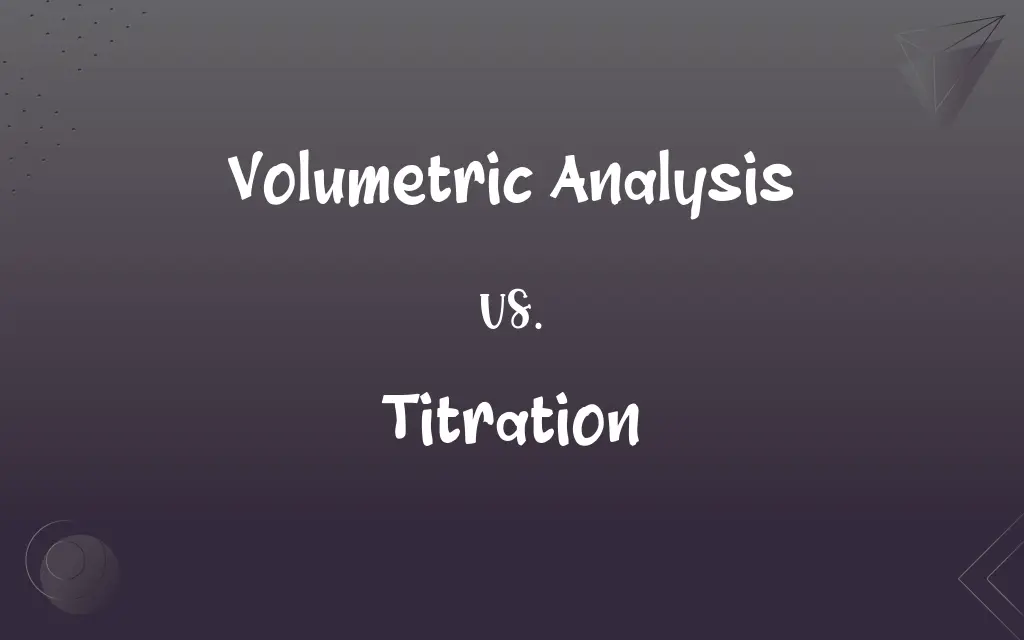Volumetric Analysis vs. Titration: What's the Difference?
Edited by Janet White || By Harlon Moss || Updated on October 25, 2023
Volumetric analysis is a method to determine the concentration of a substance, while titration is the procedure used in this analysis where a solution of known concentration is added to a solution of unknown concentration.

Key Differences
Volumetric analysis and titration are integral concepts in analytical chemistry, playing pivotal roles in determining substance concentrations. Volumetric analysis refers to a set of methods used to determine the concentration of a particular substance in a solution. It encompasses a variety of techniques, and its principle is based on the law of conservation of mass. Titration, on the other hand, is a specific technique under the umbrella of volumetric analysis. It involves the gradual addition of a solution of known concentration (titrant) to another solution of unknown concentration until the reaction between the two solutions is complete.
Volumetric analysis is a broader term and isn't limited to just titrations. It includes other methods that rely on volume measurements to determine concentrations. Titration, being a subset, is the most common and recognized technique of volumetric analysis. During a titration, an indicator might be used, which changes color to signal the end or equivalence point of the titration.
The equipment used in volumetric analysis can vary based on the method employed, but always emphasizes precise volume measurements. In titration specifically, burettes are commonly utilized because of their accuracy in delivering the titrant. Volumetric flasks, pipettes, and other volume-measuring tools are prevalent in volumetric analysis as a whole.
To summarize, while both volumetric analysis and titration center on determining concentrations through volume measurements, volumetric analysis is the overarching method, and titration is a specific procedure within it.
Comparison Chart
Definition
Method determining substance concentration
Procedure of adding known solution to unknown solution
ADVERTISEMENT
Scope
Encompasses various techniques
Specific technique within volumetric analysis
Use of Indicator
Not always
Commonly used to signal end point
Equipment
Volumetric flasks, pipettes, etc.
Burettes
Application
Broad (e.g., gas analysis, liquid analysis)
Specific reactions, usually acid-base or redox
Volumetric Analysis and Titration Definitions
Volumetric Analysis
Based on the conservation of mass principle.
The basic tenet of volumetric analysis is that matter is neither created nor destroyed.
ADVERTISEMENT
Titration
A method to determine concentration by adding a known solution to an unknown one.
The student performed a titration to find the acidity of the vinegar.
Volumetric Analysis
Used in various fields, including biology and environmental science.
Volumetric analysis is essential in pollution studies to measure contaminant levels.
Titration
Uses an indicator to signal completion.
In the titration, the solution turned pink, indicating the endpoint.
Volumetric Analysis
Relies on accurate volume measurements.
Inaccuracies in volumetric analysis can lead to significant errors in results.
Titration
Can also be used in redox reactions.
In the lab, a titration was used to find the iron content in the sample.
Volumetric Analysis
A technique determining the concentration of a substance.
Volumetric analysis helped determine the purity of the water sample.
Titration
Common in acid-base reactions.
He used titration to determine the concentration of the hydrochloric acid.
Volumetric Analysis
Encompasses a range of methods.
Besides titrations, other forms of volumetric analysis are employed in the lab.
Titration
Involves precise volume measurements.
A successful titration relies on accurate burette readings.
Titration
The process, operation, or method of determining the concentration of a substance in solution by adding to it a standard reagent of known concentration in carefully measured amounts until a reaction of definite and known proportion is completed, usually as shown by a color change or by electrical measurement, and then calculating the unknown concentration.
Titration
(analytical chemistry) The determination of the concentration of some substance in a solution by slowly adding measured amounts of some other substance (normally using a burette) until a reaction is shown to be complete, for instance by the colour change of an indicator.
Titration
The act or process of titrating; a substance obtained by titrating.
Titration
A measured amount of a solution of unknown concentration is added to a known volume of a second solution until the reaction between them is just complete; the concentration of the unknown solution (the titer) can them be calculated
FAQs
Can volumetric analysis be performed without titration?
Yes, volumetric analysis includes other methods beyond titration.
What is volumetric analysis?
Volumetric analysis is a method used to determine the concentration of a substance in a solution.
How is titration related to volumetric analysis?
Titration is a specific procedure used within volumetric analysis.
Why is the conservation of mass principle important in volumetric analysis?
It ensures that the amount of substance remains constant, allowing for accurate concentration determinations.
What are some common titrants used in titration?
Common titrants include sodium hydroxide, hydrochloric acid, and potassium permanganate.
Do all titrations need an external indicator?
No, some reactions, like those with potassium permanganate, serve as their own indicator.
What's the end point in titration?
It's the point where the reaction between the two solutions is complete, often indicated by a color change.
Can errors in volumetric analysis impact research outcomes?
Absolutely, inaccuracies in volumetric analysis can lead to skewed results.
Are there alternative methods to titration for concentration determination?
Yes, there are other analytical methods like spectroscopy, but titration is often chosen for its simplicity and accuracy.
How is volumetric analysis used in real-world applications?
It's used in areas like pharmaceuticals, environmental testing, and quality control.
What equipment is unique to titration?
Burettes are commonly used in titration for their precise volume delivery.
How do you ensure accuracy in volumetric analysis?
Using calibrated equipment, following procedures, and practicing good lab technique ensure accuracy.
What's the difference between the end point and equivalence point in titration?
The end point is observed, often with a color change, while the equivalence point is where stoichiometrically equivalent amounts of substances have reacted.
Why is accurate volume measurement crucial in titration?
Precise measurements ensure accurate results and determine the unknown concentration correctly.
Do all titrations use indicators?
Not always, but indicators are commonly used to signal the end point of a titration.
Can titration be used for reactions other than acid-base?
Yes, titration can also be used for redox reactions and others.
How do you choose an indicator for titration?
The indicator should change color near the equivalence point of the reaction.
Can you use volumetric analysis for gases?
Yes, there are specific volumetric methods for gas analysis.
How do you calculate the concentration after a titration?
By using the known volume and concentration of the titrant and the volume of the unknown solution.
Are there automated methods for titration?
Yes, automated titrators can perform the process with increased precision and speed.
About Author
Written by
Harlon MossHarlon is a seasoned quality moderator and accomplished content writer for Difference Wiki. An alumnus of the prestigious University of California, he earned his degree in Computer Science. Leveraging his academic background, Harlon brings a meticulous and informed perspective to his work, ensuring content accuracy and excellence.
Edited by
Janet WhiteJanet White has been an esteemed writer and blogger for Difference Wiki. Holding a Master's degree in Science and Medical Journalism from the prestigious Boston University, she has consistently demonstrated her expertise and passion for her field. When she's not immersed in her work, Janet relishes her time exercising, delving into a good book, and cherishing moments with friends and family.
































































